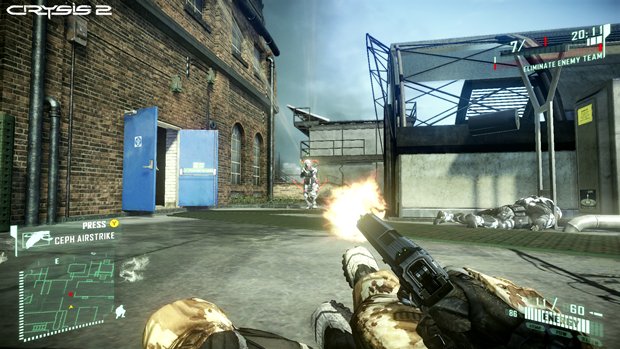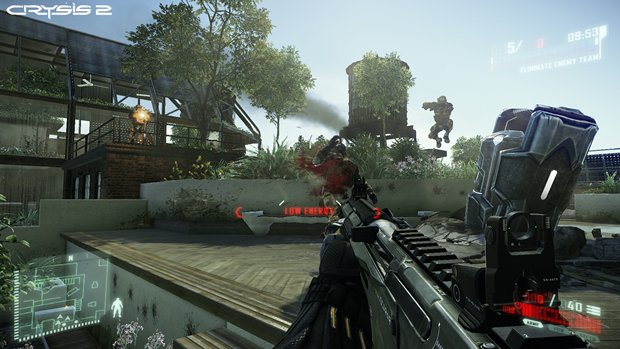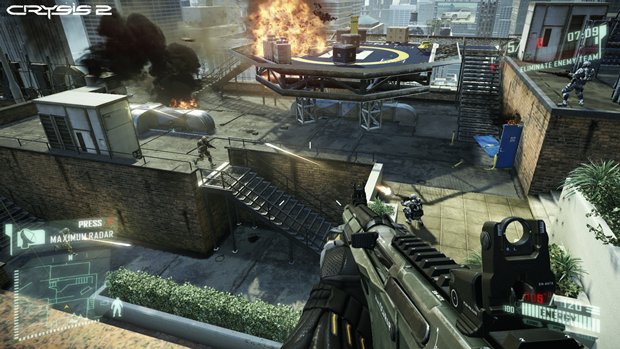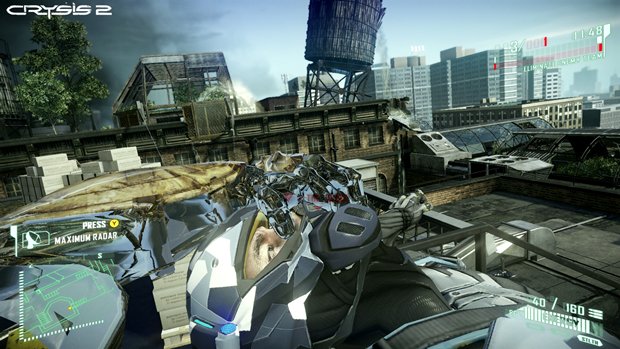Crysis 2 hands-on multiplayer preview
Concessions for console: dumbed-down, or streamlined?
The original Crysis is of course best known for bringing PCs to their circuit-laced knees with its unheard-of graphical possibilities. It’s possibly still the best-looking game ever made, and it came out over three years ago. So when one considers that the PC-only franchise is coming to consoles as well, it’s not easy to figure out how. The reality is that Crysis 2 doesn’t look as good as the original… at least on consoles. Yet clearly the new engine is a bit of technical wizardry because it still looks really, really good. It will be interesting to see how it looks on a top-of-the-line PC, but console owners don’t have to worry about some cruddy-looking port.

Above: The environments don't really help to show off the engine, since they're mostly bland buildings and streets. Check out the swanky John Woo slide, though
What first time Crysis players won’t notice is how the control scheme has been significantly simplified, and we’re guessing it’s due to the limited buttons on a controller. See, in the original Crysis, the nanosuit – the tech that gives your soldier super-human abilities – had four distinct modes that all had to be juggled for maximum badassery. With the near-endless input possibilities of a keyboard, it was a simple matter to use hotkeys to flip quickly from armor, to stealth, to speed, to strength. That aspect of the game was our favorite part of it – not the fancy-pants graphics. Each mode had a pro and a con, so it made the game tactical, fun, and felt like you could make up playstyles on the fly.
With Crysis 2, there are only two special nanosuit modes, since the default doesn’t do anything different than the activated modes from what we could see. So now you have the choices of stealth and armor. The armor mode sort of combines the old versions of armor and strength, but the main reason to activate it is for the defensive bonus. Both special suit modes drain your energy, so the multiplayer becomes a contest of not just who can fight the best, but also who can manage their resources the best. For instance: at the start of a match, there’s no point in activating an ability since the enemy is still across the map. But then it becomes an instinctive thing: how long do you wait before activating stealth? The longer you wait, the better usage of the invisibility will be, but you might get caught with your pants down.

Above: You don't want to see "low energy" on screen, but it will happen a lot, since getting shot drains your energy
Swapping between stealth and armor while also managing weapons and vision modes (thermal will help you spot stealthers) is a lot to keep track of, so it’s possible that the simplifying of the nanosuit abilities will be beneficial for multiplayer. It certainly fits with the fast-paced combat, although the speed we’re talking about is more in the agility of the avatars rather than the time it takes to kill someone. Indeed, you won’t die so readily here, even without using the armor ability, as say Call of Duty. It doesn’t take ages to kill someone, but people don’t feel like they’re made out of paper, either.
In fact, playing Crysis 2 multiplayer reminds us a bit of Mirror’s Edge, since your foot speed is faster than most contemporary shooters (but still isn’t quite Quake levels of speed) and you can vault and perform crazy slides. Vaulting is a part of every shooter nowadays, but Crysis 2 has an especially generous and fast vault, which means you can run, leap, and grab ledges with ease and not be exposed for long. The slide is particularly impressive, as it lasts a good thirty feet or more, and you can stylishly fire away while keeping a low profile.
Sign up to the GamesRadar+ Newsletter
Weekly digests, tales from the communities you love, and more

The other major changes to the multiplayer since the first Crysis include the standard RPG-ish leveling system that unlocks custom classes and additional weapons, while new game modes mix up the limited roster we saw before. Earning extra XP by performing skillshots (we’re not sure what these constitute yet) and activating special abilities like maximum radar and air strikes add in some arcade touches to the drier Crysis template. New game modes don’t offer anything revolutionary, but we had some exciting moments during rounds of Extraction, where one team must capture two mysterious objects and carry them to their helicopter. Sure, it’s a slightly modified capture-the-flag, but adding in stealth and super jumps means that there are some sneaky methods for grabbing the “flag” out from under opponents’ noses.
We also noticed how the level design involves quite a bit of vertical space, since everyone can reach higher levels with ease. On the streets of Manhattan, the maps provide piled-up car wrecks to leap on and various crumbling ledges to scale for plenty of hidden ambushes. We managed to creep above a few opponents, power-leap directly over them, and then use the nanosuit’s ground-pound attack for a spectacular surprise kill. That move will likely never get old. On another map, the entire battle takes place on a series of skyscraper roofs, adding a sense of vertigo to the fight. We didn’t fall off any ledges, or see anyone else tumble to their doom, but we’re hoping there are going to be some funny ways to send enemies plummeting.

Above: Get behind an opponent while invisible and you'll get a fun stealth kill
While the unusually fast paced action and ninja-ish moves give Crysis 2’s multiplayer its own identifiable flavor, we wish that more had been done to make it feel different from other shooters around. The leveling and class system and game modes are all things we’ve seen before with nothing innovative added on top. The nanosuit abilities are fun to play with and may lead to more complex tactics, but we got a distinct sense that over time the multiplayer may not serve up enough variety to maintain a playerbase – that is, unless additional content expands upon the core elements. At the same time, we’ve only seen a taste of what the multiplayer has to offer – we’d need full exposure to all the equipment, maps, and modes to see how robust the component will truly be.
Jan 25, 2011



